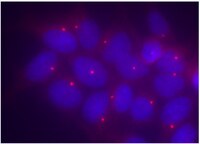ABN1720 Sigma-AldrichAnti-Ninein
Anti-Ninein, Cat. No. ABN1720 is a highly specific rabbit polyclonal antiserum that targets Ninein and has been tested in Immunocytochemistry, Immunofluorescence, Immunohistochemistry, and Western Blotting.
More>> Anti-Ninein, Cat. No. ABN1720 is a highly specific rabbit polyclonal antiserum that targets Ninein and has been tested in Immunocytochemistry, Immunofluorescence, Immunohistochemistry, and Western Blotting. Less<<Recommended Products
Overview
| Replacement Information |
|---|
Key Specifications Table
| Species Reactivity | Key Applications | Host | Format | Antibody Type |
|---|---|---|---|---|
| M, R, H | ICC, IHC, IF, WB | Rb | Serum | Polyclonal Antibody |
| References |
|---|
| Product Information | |
|---|---|
| Format | Serum |
| Presentation | Rabbit polyclonal antibody serum with 0.05% sodium azide. |
| Quality Level | MQ100 |
| Physicochemical Information |
|---|
| Dimensions |
|---|
| Materials Information |
|---|
| Toxicological Information |
|---|
| Safety Information according to GHS |
|---|
| Safety Information |
|---|
| Packaging Information | |
|---|---|
| Material Size | 100 µL |
| Transport Information |
|---|
| Supplemental Information |
|---|
| Specifications |
|---|
| Global Trade Item Number | |
|---|---|
| Catalog Number | GTIN |
| ABN1720 | 04054839034466 |
Documentation
Anti-Ninein Certificates of Analysis
| Title | Lot Number |
|---|---|
| Anti-Ninein - 3311818 | 3311818 |
| Anti-Ninein - 3905493 | 3905493 |
| Anti-Ninein - 4040879 | 4040879 |
| Anti-Ninein - 4067221 | 4067221 |
| Anti-Ninein -Q2726973 | Q2726973 |









